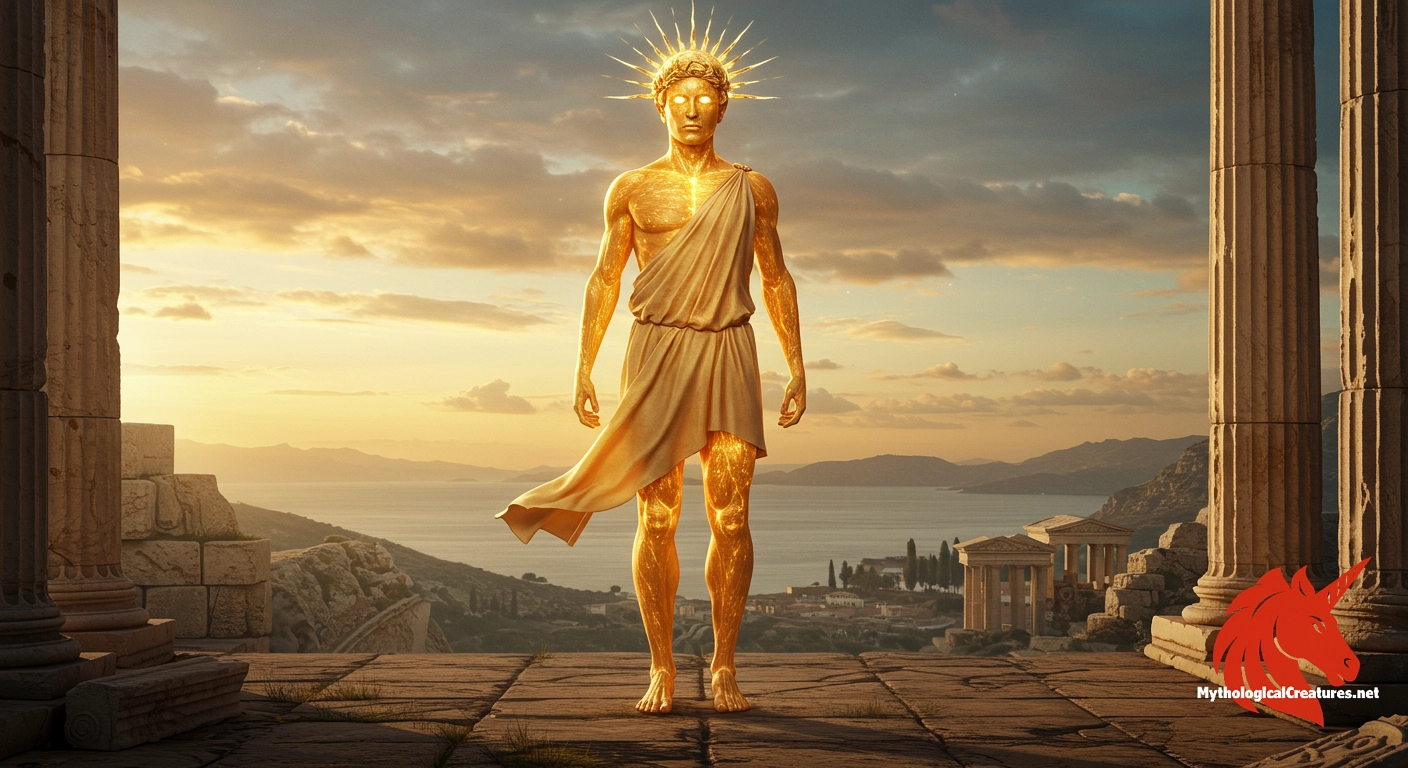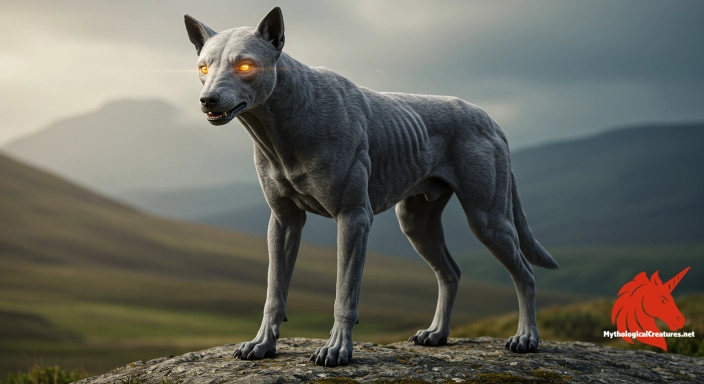Helios: Helios is the ancient Greek god who personifies the Sun, revered for driving his radiant chariot across the sky.

Helios
Helios - Helios not only embodied the physical sun but also served as an eternal witness to oaths and actions, influencing both religious practices and later solar deities.
Origins & First Encounters
Helios is the quintessential personification of the sun in ancient Greek mythology, embodying both the literal and metaphorical light that illuminates the world. Born of the Titans Hyperion and Theia, his origins are deeply entwined with the cosmic order and the early ideas of divine ancestry in the Greek pantheon. He emerges in early literary traditions as a powerful yet ever-present force whose daily journey across the sky provided a rhythmic order to both nature and human life. His depiction as a radiant deity who traverses the heavens in a chariot underlines his role as a bringer of day and a guardian of oaths, ensuring that every promise made in his light remains unbroken. Throughout early Greek literature, from epic poetry to fragmented hymns, Helios consistently symbolizes clarity, truth, and justice. His power is further stressed in narratives that recount the tragic fate of his mortal son Phaethon, a story that explores the dangers of overreaching ambition. His revered status in local communities is evident in the grand temples and elaborate rites dedicated to him, particularly in regions such as Rhodes and Corinth. Helios was more than just a solar icon; he represented the eternal cycle of renewal as day succeeded night and the perpetual watchfulness of the divine over mortal affairs. His enduring imagery in art, literature, and ritual underscores his significance as a unifying symbol of natural order and celestial power. Ultimately, Helios’s mythic presence offers a timeless bridge between the observable universe and the human quest for cosmic understanding.
Source Texts & Tale Variants
Ancient literary sources portray Helios through a multifaceted lens, starting with the Homeric epics which vividly illustrate his role as the omnipresent, all-seeing sun deity. His lineage is meticulously set out in Hesiod’s Theogony, which roots his identity firmly in the ancient divine order. The poetic narratives of the classical period further elaborate on his celestial journey, providing varied accounts that celebrate his daily passage across the sky. In works such as the Odyssey, the consequences of defying his sacred prerogatives—exemplified by the fate of those who harmed his hallowed cattle—are recounted in powerful, cautionary tales. Regional inscriptions and dedications found in cult centres like Rhodes introduce additional layers of narrative, each contouring his myth to fit local traditions and religious observances. Later Hellenistic poets and playwrights revisited his story, often blending or contrasting his identity with similar solar figures such as Apollo. Textual fragments and ritual texts also depict Helios as a divine witness in magical rites, emphasising his function as an arbiter of truth. Over time, Roman sources further adapted his mythos, merging his characteristics with the broader concept of solar divinity, thus ensuring that his legacy was both multifaceted and enduring.
Form & Powers
Artistic representations of Helios bring to life his transcendent and dynamic physical form, which has captivated imaginations for millennia. Often shown as a youthful, beardless figure, his visage radiates an ethereal brilliance that captures the essence of the sun itself. His luminous countenance, framed by waves of golden hair, is frequently adorned with a glittering crown that mirrors the celestial corona, symbolising his authority over the day. Detailed depictions in sculpture and vase-painting reveal him in a flowing chiton that seems to shimmer with light, emphasising his connection to the natural world. Integral to his iconography is the splendid horse-drawn chariot, whose elaborate design and spirited steeds convey the relentless energy and movement of the solar journey. His eyes, frequently rendered with an intense, penetrating gaze, reflect the all-seeing power associated with his divine vigilance. Variations in his portrayal—from tender pastoral images to majestic, awe-inspiring depictions—highlight the flexibility of his myth to encompass both nurturing and formidable aspects. The interplay of light and shadow in his artistic renderings further underlines his role as a mediator between the day and the night, the mortal and the divine. Each detail of his physical appearance is carefully crafted to evoke the splendour, potency, and timeless grace of the sun.
Regional Faces
The myth of Helios evolved distinctly across various regions in the ancient Greek world, reflecting local customs and religious practices. In Rhodes, he was not only revered as a divine symbol of light but also celebrated as the island’s patron, embodied by monumental statues and dedicated temples designed to capture his majestic aura. In Corinth and the wider Corinthia region, his sacred presence was intricately tied to civic rituals and oaths, underscoring his role as an incorruptible witness to human integrity. Diverse local traditions brought subtle shifts to his iconography, with some communities emphasizing his youthful energy and others portraying him as an almost regal, timeless arbiter of natural order. Hellenistic influences further enriched these regional versions, producing syncretic legends that sometimes merged his identity with other deities, notably Apollo, while still preserving uniquely local attributes. Regional festivals often celebrated his journey across the heavens, aligning his myth with seasonal cycles and significant agricultural events. Local inscriptions and archaeological finds reveal that his worship was as much a civic celebration as it was a personal offering to a divine being. This regional plurality not only deepened the layers of his myth but also ensured that Helios remained a versatile symbol whose essence varied to mirror the spiritual and cultural needs of each community.
Cultural Parallels
Helios’s mythological persona offers rich ground for comparative analysis with solar deities from a variety of cultural traditions. His radiant qualities and the daily traversal of the sky find echoes in the Roman iconography of Sol and, at times, in the dual identity of Apollo, highlighting recurring themes of luminescence and vigilance. In parallel, the Egyptian sun god Ra embodies many of the same attributes as Helios, merging the ideas of cosmic creation, renewal, and moral vigilance in a myth that resonates across civilizations. Similarly, figures like the Mesopotamian Shamash and the Vedic Surya share the dual role of life-bringer and divine judge, reinforcing the concept that the sun serves as an eternal arbiter of truth in human affairs. These cross-cultural comparisons underscore how the sun, in its apparent simplicity, holds profound symbolic meaning, bridging mythologies from diverse geographic corners. While Helios stands out for his unique narrative details and Greek cultural context, his shared motifs with other solar deities reveal a universal human response to the awe-inspiring power of the sun. Distinctions also emerge in the way each culture emphasises different aspects of solar influence, whether it be the rigorous administration of justice or the nurturing aspect of life-giving light. Such comparative observations remind us that Helios is part of a broader, interconnected tradition where the brilliance of the sun is celebrated in myriad yet resonant ways. Ultimately, examining Helios alongside his counterparts enriches our understanding of ancient cosmological thought and the common symbolic language of light.
Legacy & Modern Evolution
The legacy of Helios has undergone a profound evolution from his ancient origins to his place in modern cultural imagination. His initial portrayal as the steadfast journeyer of the sky eventually merged with other solar identities, notably during periods when syncretism blended his character with that of Apollo and the Roman Sol. In the late antique period, his myth received a revival, most notably under Emperor Julian’s reformist attempts to restore traditional Roman religious practices centred on the sun. Through the modern era, Helios’s image has been continually reinterpreted, appearing in literature, art, and even popular media as a symbol of clarity, renewal, and unyielding power. Contemporary aesthetics often draw on his radiant iconography to evoke themes of natural beauty and timeless dynamism, ensuring that his myth remains relevant. Modern spiritual movements and neo-pagan practices have also embraced Helios, celebrating him in solstice festivals and rituals that highlight his enduring connection to nature. The flexible symbolism of Helios, encapsulating both the nurturing and destructive facets of the sun, continues to inspire creative reinterpretations and scholarly debate. His story serves as a testament to the ways in which ancient myth can be continuously reimagined to address contemporary human experiences, linking the past with the present under the universal light of the sun. Today, Helios remains a potent emblem for both historical inquiry and modern artistic expression, ensuring that his luminous legacy burns brightly through the ages.
Interesting Fact
Despite being a relatively minor deity in Classical Greece, Helios's role as both a divine observer and an enforcer of oaths has left an indelible mark on mythology, influencing later depictions of solar gods and the integration of solar symbolism in magic and legal traditions.
Quick Creature Info
Origin:
Associations:
Our Mythic Legendary Rating:

Also Sometimes Known As:
Habitat:
Supernatural Powers:
Physical Attributes:
Abilities:
Behavior:
Lore:
References
Discover Another Mythical Legend You May Not Have Heard Of?
Uncover the mysteries of ancient folklore and expand your knowledge of legendary beings from cultures around the world.
Dare to Meet the Failinis....
Mythical Disclaimer: The images and data on this site are derived from various historical and literary sources, but we have found that many myths often have multiple versions and interpretations across references, sometimes contradictory. As a result, these creature depictions are artistic interpretations—imaginative blends of folklore, legend, and a dash of AI guesswork. Because creature descriptions vary widely, our illustrations and accompanying information represent our best effort to honor mythology while bridging creative gaps. Enjoy these interpretations—just remember, we've done our best to respect the stories and validate available data, but in the realm of mythology, details often shift, imagination leads the way, and nothing is ever set in stone!
Curated by the Mythological Creatures Team (rev. May 2025)
